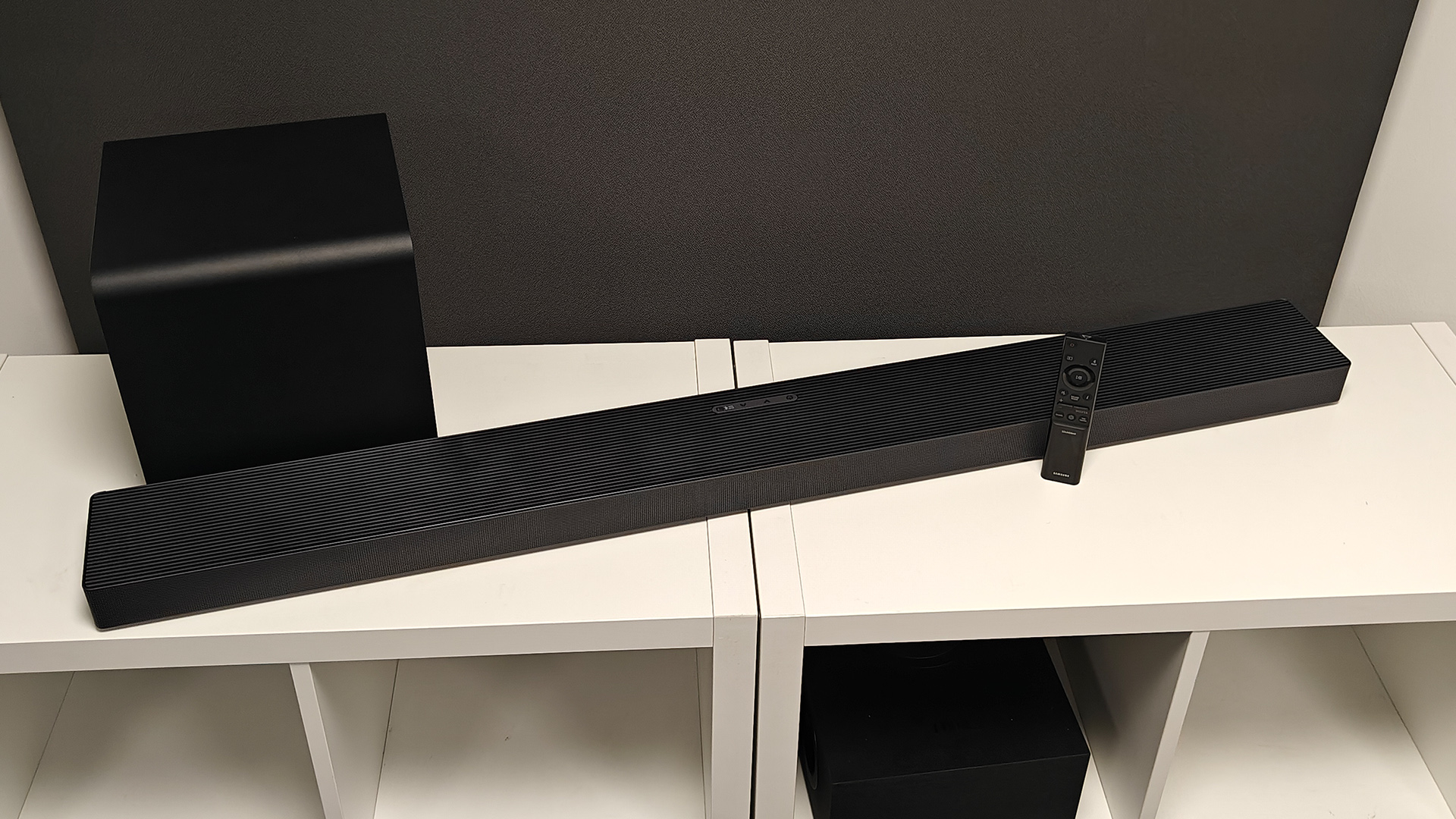Philips 2024 TV range guide: our experts detail what you need to know
Philips has OLED, Mini LED and LCD TVs on the menu for 2024. Here are all the details we have so far.
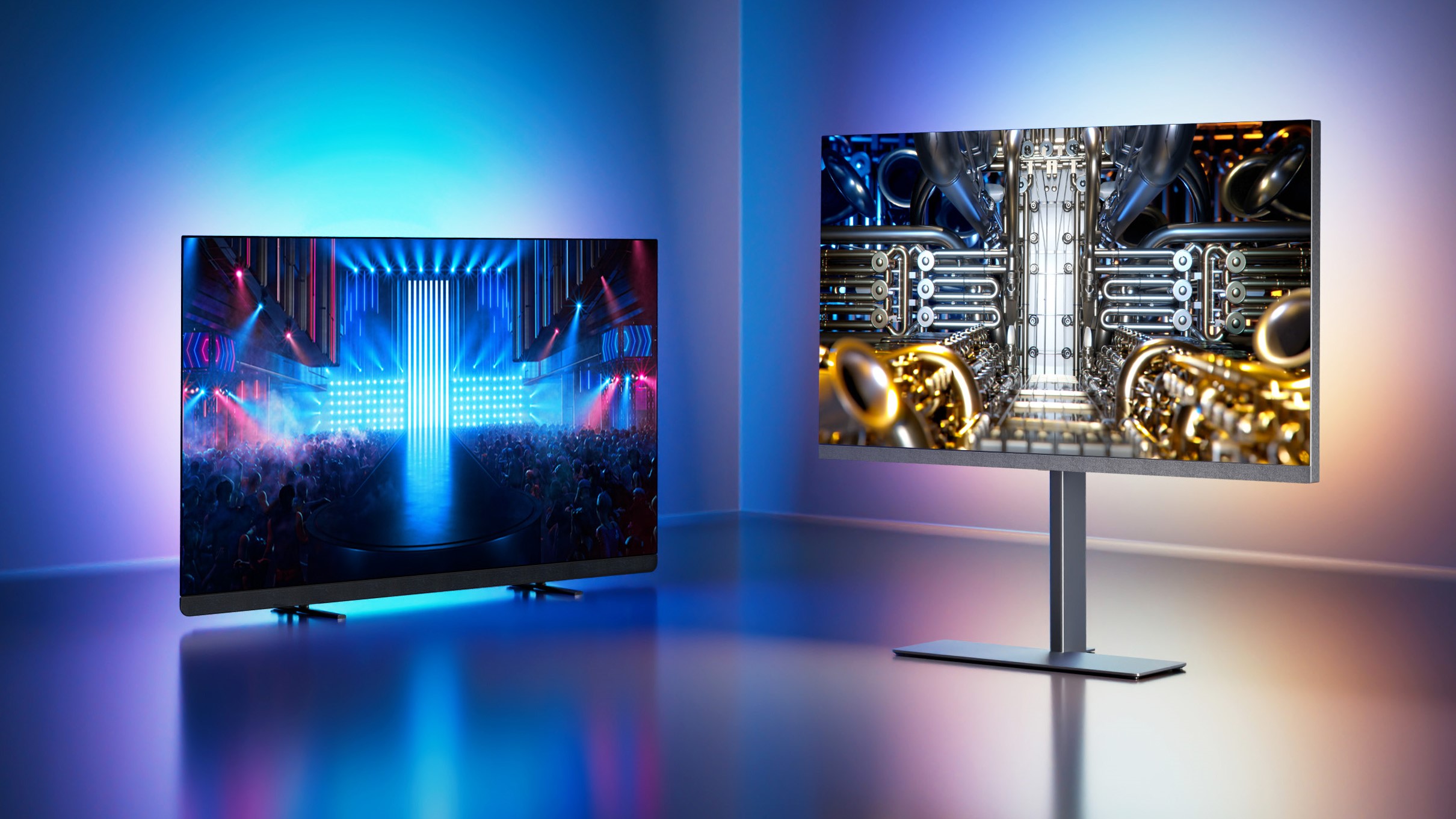
Philips has unveiled its full TV lineup for 2024, including new OLED+ and OLED TV models, a Mini LED offering, and an entry-level LCD option.
The six-strong lineup is headed up by two premium OLED panels this year, the top-tier OLED+959 flagship offering being the first one of its level we’ve seen since 2022.
They both offer second-gen Micro Lens Array (MLA) panels with 3000-nit peak brightness promises, as well as new Ambilight technology in the OLED+959, and the return of four-sided Amblight in its sibling.
Elsewhere the range looks familiar, with an introductory OLED model to take on the likes of LG’s C4, and additions to the Xtra and The One ranges.
We’ve pulled together all the info you need to know on the Philips 2024 TV lineup below including our hands-on impressions having seen them at a press launch event earlier this year. We'll also add to this guide as we find out more, so make sure to keep checking back with What Hi-Fi?.
Second-gen MLA brings 3000 nits of brightness
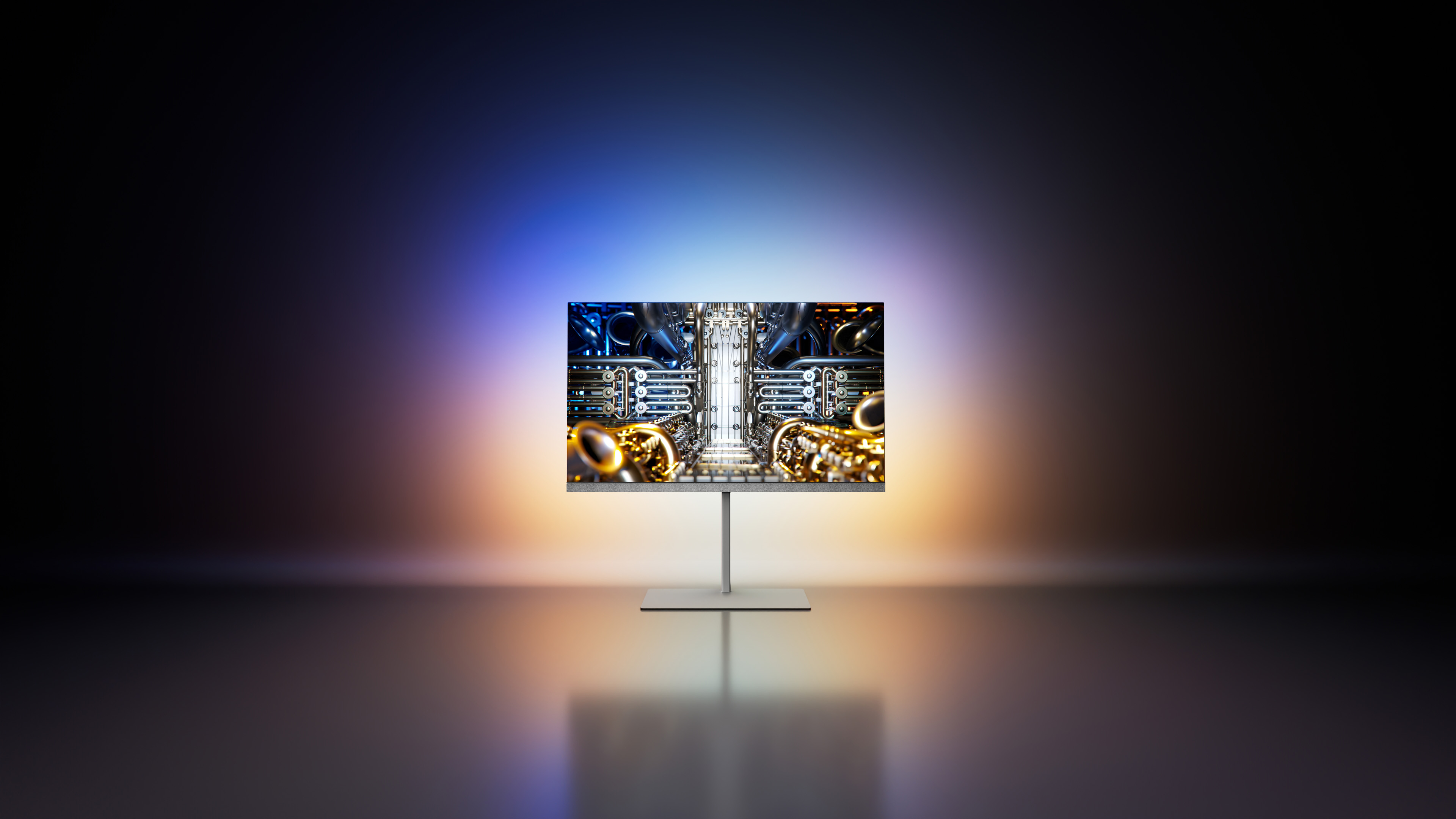
While other manufacturers have been somewhat coy with peak brightness figures of their 2024 second-gen MLA screens, Philips has gone all in on a 3000-nit claim (on a 3 per cent window) for its OLED+959 and OLED+909 TVs.
That’s a new high for the technology – something Philips says its Meta 2.0 OLED panel can manage thanks to its new Meta Multi Booster algorithm.
The latest hi-fi, home cinema and tech news, reviews, buying advice and deals, direct to your inbox.
It’s a step up from the 2100 peak brightness promised by last year’s OLED908, and should mean that HDR images are all the more impactful, particularly against OLEDs deep blacks. We'll make sure to test the claim when we get the new sets into our viewing rooms later this year.
8th Gen P5 AI processor brings PQ improvements

As is usually the case with every range update, an upgraded processor is running the show here, specifically the 8th Gen P5 AI.
One of the biggest improvements this powers is the Ambient Intelligence V3, which now includes the smart optimisation of HDR to the ambient light level, a bit like Dolby Vision IQ.
A Dual Engine version of this processor is reserved for the very top TV in the range, the OLED+959, and the additional power here helps to push two further processing improvements.
These are AI Machine Sharpness V2, which uses a new algorithm to sharpen up and introduce more detail to areas of an image that require it, and Smart Bit Enhancement V3, which will tidy up the appearance of banding in lower quality content.
Introducing Ambilight Plus

Ambilight remains one of the biggest USPs for investing in a Philips TV, and at the top of its 2024 range, Philips has made one of the biggest upgrades to the tech that we’ve seen in years.
Ambilight Plus builds on what has become increasingly sophisticated experience, by adding multiple lenses to the individual, rear-mounted colour LEDs, spreading
The result is a much more accurate and dynamic coloured light display, which can more accurately map and mimic the various colours on the screen.
Having seen an early demo of the tech, we loved the added dynamism it had to offer and look forward to seeing it in action properly soon.
B&W sound gets a boost

As we’ve seen for several years now, Philips has handed over the responsibility of sound to Bowers & Wilkins for its two most premium models.
This year, that has meant B&W designing bespoke slimline drivers (30 x 50mm) to handle business in the midrange, alongside 19mm titanium dome tweeters with a Nautilus tube – tech borrowed from B&W’s high-end Nautilus speaker range.
In the OLED+959, there are no less than 18 drivers creating a Dolby Atmos-capable 5.1.2 speaker set up, built in and around the screen.
This is made up of dedicated front-firing left, centre and right speakers in a slender soundbar underneath the screen. Accompanying this are left and right side-firing speakers and left and right upward-firing Atmos channels – all acoustically isolated, mounted in their own rigid enclosures.
At the rear of the TV, there’s a dedicated bass enclosure with a 75mm subwoofer supported by two pairs of balanced 45 x 65mm passive radiators. There’s also the ability to add a separate sub if you wish.
No less than 12 channels of amplification give a total power rating of 102W, with each channel boasting its own dedicated signal processing.
This moves down to a 3.1ch system for the OLED+909, which loses the upwards and side-firing speakers, but keeps the slimline soundbar along the bottom. With eight channels of amplification, this TV has a sound output of 81W.
Titan OS: a new operating system
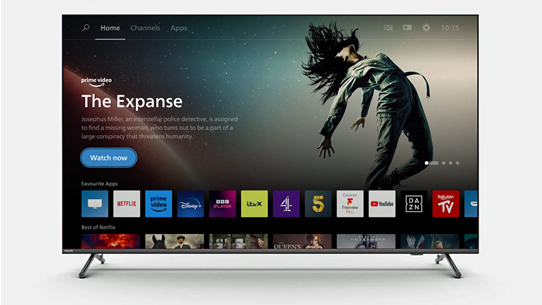
Philips has split its operating system focus this year, leaving its OLED TVs with Google OS as before, but introducing the new Titan OS for its more affordable ranges.
Created by a European software development company made up of industry experts from the likes of Roku, Disney and Rakuten, Titan OS will feature on the PML9009 Xtra Mini-LED and "The One" PUS8909. It’ll also feature on some JVC sets through a partnership with Currys, who make and distribute them.
Further details are currently low on the ground but we do know that it promises all the on-demand apps you’d expect, including Disney+, Netflix, Prime Video, YouTube and more.
Philips 2024 TV range breakdown
Now we've caught up on some of the headline new features across the range, it's time to take a closer look at every model individually. Keep reading for all the details, we'll update this with more as soon as we get it.
Philips OLED+959

The Philips OLED+959 is the flagship TV for 2024, and like the flagship models from LG and Panasonic, it uses second-generation MLA OLED technology for its panel.
However, by combining this technology with Philips' own Meta Multi Booster algorithm, the OLED+959 is promising a whopping 3000-nit peak brightness (on a 3 per cent window) — currently market-leading figures in the OLED world.
Philips didn't announce an equivalent model for this statement design-led TV in 2023, but it makes a welcome return in 2024, with an aluminium and steel floornstand and integrated Bowers & Wilkins sound system.
That makes the OLED+959 most reminiscent of 2021's OLED+986, but with a more discreet, slimline built-in soundbar design this time round, tucked directly below the screen.
However, drivers are also tucked away to the side and top of the panel, as well as directly behind it, delivering an Atmos-capable 5.1.2-channel sound system with 102W of power.
Ambilight Plus is introduced here – a more accurate and dynamic version of the technology that can more closely track the colours on the screen with what is projected behind.
Powered by the new 8th Gen P5 AI Dual Engine driver, the OLED+959 also benefits from a trio of picture quality improvements – namely Ambient Intelligence V3 for automatic HDR tweaking depending on ambient light conditions, AI Machine Sharpness V2 for improving detail retrieval and a new Smart Bit Enhancement algorithm for improving banding in low-quality sources.
Gaming performance has been improved with the addition of 4K/144Hz support, up from 4K/120Hz, including for Dolby Vision gaming (when it's available). As before, there's support for VRR and ALLM, plus a new Game Bar for customising and enhancing your gaming experience.
Another new addition is MEMC (Motion Estimation Motion Compensation) gaming for reducing judder with minimal latency – but the fact is, you'll get much lower latency in Game Mode with MEMC switched off. Still, it's there if you want to try it out. The only downside to all of this is there are only two HDMI 2.1 ports once again this year, which is a little frustrating.
The OLED+959 will only be available in 65 inches, and will be available towards the end of this year.
Philips OLED+959 specs
- Sizes: 65 inch
- Display type: OLED with second-gen MLA
- Resolution: 4K
- Processor: 8th Gen P5 AI Dual Engine
- Sound: 5.1.2-channel sound, 102W
- HDMI 2.1: Yes (x2)
- Picture features: Ambilight Plus, Ambient Intelligence V3, AI Machine Sharpness V2, Smart Bit Enhancement
- Gaming features: 4K/144Hz, VRR, ALLM, new Game bar, MEMC gaming
Philips OLED+959 pricing
- Philips 65OLED959: £TBC / $TBC / AU$TBC
Philips OLED+909
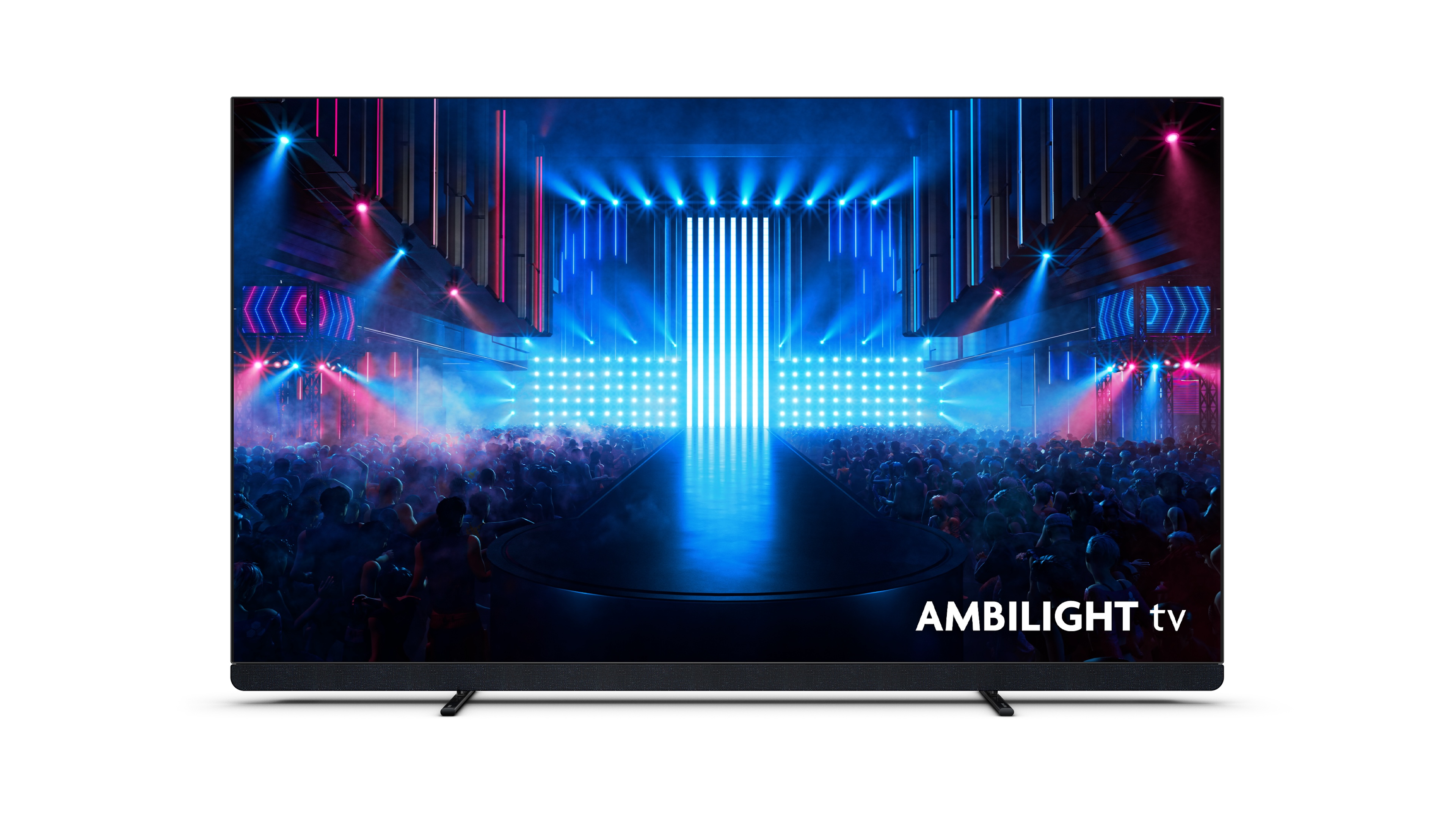
The OLED+909 is going to be the flagship Philips TV for many people, particularly those looking for a more traditional table-top stand or who would like to wall mount their TV.
It's a super slender set with minimalist metal bezels and low-profile pill-shaped feet. It packs the same second-gen MLA panel as the OLED+959, complete with the Meta Multi Booster algorithm for peak brightness up to 3000 nits (on a 3 per cent window).
It also has Philips’ latest 8th Gen P5 AI processing, but the single chip version. That means it misses out on the AI Machine Sharpness V2 and Smart Bit Enhancement, but does get the Ambient Intelligence V3 for light-optimising HDR.
While it misses out on Ambilight Plus, it does get four-sided Ambilight for maximum impact, and gets a stepped down B&W sound system to boot.
That consists of a 3.1ch front-firing soundbar that runs along the bottom of the screen, with 81W of power and the option to add an additional sub if you wish.
Gaming options remain the same as they are on the OLED+959 with support for 4K/144Hz, VRR and ALLM across two HDMI 2.1 ports, alongside the MEMC functionality and new Game Bar.
It'll be available in a choice of 55-, 65- and 77-inch screen sizes.
Philips OLED+909 specs
- Sizes: 55, 65, 77 inch
- Display type: OLED with second-gen MLA
- Resolution: 4K
- Processor: 8th Gen P5 AI
- Sound: 3.1-channel sound, 81W
- HDMI 2.1: Yes (x2)
- Picture features: Four-sided Ambilight, Ambient Intelligence V3
- Gaming features: 4K/144Hz, VRR, ALLM, new Game bar, MEMC gaming
Philips OLED+909 pricing
- Philips 55OLED909: £TBC / $TBC / AU$TBC
- Philips 65OLED909: £TBC / $TBC / AU$TBC
- Philips 77OLED909: £TBC / $TBC / AU$TBC
Philips OLED809

The Philips OLED 800 Series has commonly been one of the most popular sets from the company, thanks to its ability to balance out performance and value for money.
The OLED809 will be certainly be aiming for more of the same, with a great selection of screen sizes, including 42, 48, 55, 65 and 77 inches.
There’s a minimalist design across the range, with a black metal bezel and satin chrome central metal swivel stand in all but the 77-inch model, which opts for metal feet instead.
It packs the same new 8th Gen P5 AI processor as the OLED909, but the biggest difference here is that it uses one of the new higher output OLED_EX panels and not MLA.
That means peak brightness is down from 3000 nits to 1300 nits.
The new Ambient Intelligence V3 is on board here to keep HDR looking impactful in a brighter room, as is regular three-sided Ambilight. 4K/144Hz gaming is the same here as the higher up ranges too, with VRR, ALLM, the MEMC gaming feature and the new Game Bar.
Sound isn’t handled by B&W in the OLED809, but it still manages 70W from a 2.1 integrated sound system (50W for the 42 inch). A more accurate digital crossover precisely controls the distribution to the two-way left and right speakers, plus there’s a dedicated triple ring, rear-facing bass driver supported by four passive radiators in control of the low end.
Philips OLED809 specs
- Sizes: 42, 48, 55, 65, 77 inch
- Display type: OLED
- Resolution: 4K
- Processor: 8th Gen P5 AI
- Sound: 2.1-channel sound, 70W
- HDMI 2.1: Yes (x2)
- Picture features: Three-sided Ambilight, Ambient Intelligence V3
- Gaming features: 4K/144Hz, VRR, ALLM, new Game bar, MEMC gaming
Philips OLED809 pricing
- Philips 42OLED809: £TBC / $TBC / AU$TBC
- Philips 48OLED809: £TBC / $TBC / AU$TBC
- Philips 55OLED809: £TBC / $TBC / AU$TBC
- Philips 65OLED809: £TBC / $TBC / AU$TBC
- Philips 77OLED809: £TBC / $TBC / AU$TBC
Philips OLED759
Details on this entry-level OLED are thin on the ground, but we know about its existence following a discussion with Philips’ senior director of product strategy and planning, Danny Tack.
From our chat, it seems like this model will lose out on the benefits of the 8th Gen P5 AI chip, and will use the Novatek 7th Gen P5 instead. The upside to this will be for gamers, with the inclusion of four HDMI 2.1 ports. A competitor for LG's B4, perhaps?
We're chasing Philips for more details on this and will update this piece as soon as we have them.
Philips OLED759 specs
- Sizes: TBC
- Display type: OLED
- Resolution: 4K
- Processor: 7th Gen P5
- Sound: TBC
- HDMI 2.1: Yes (x4)
- Picture features: TBC
- Gaming features: TBC
Philips OLED759 pricing
- Philips OLED759: £TBC / $TBC / AU$TBC
Philips PML9009 - "The Xtra Series"
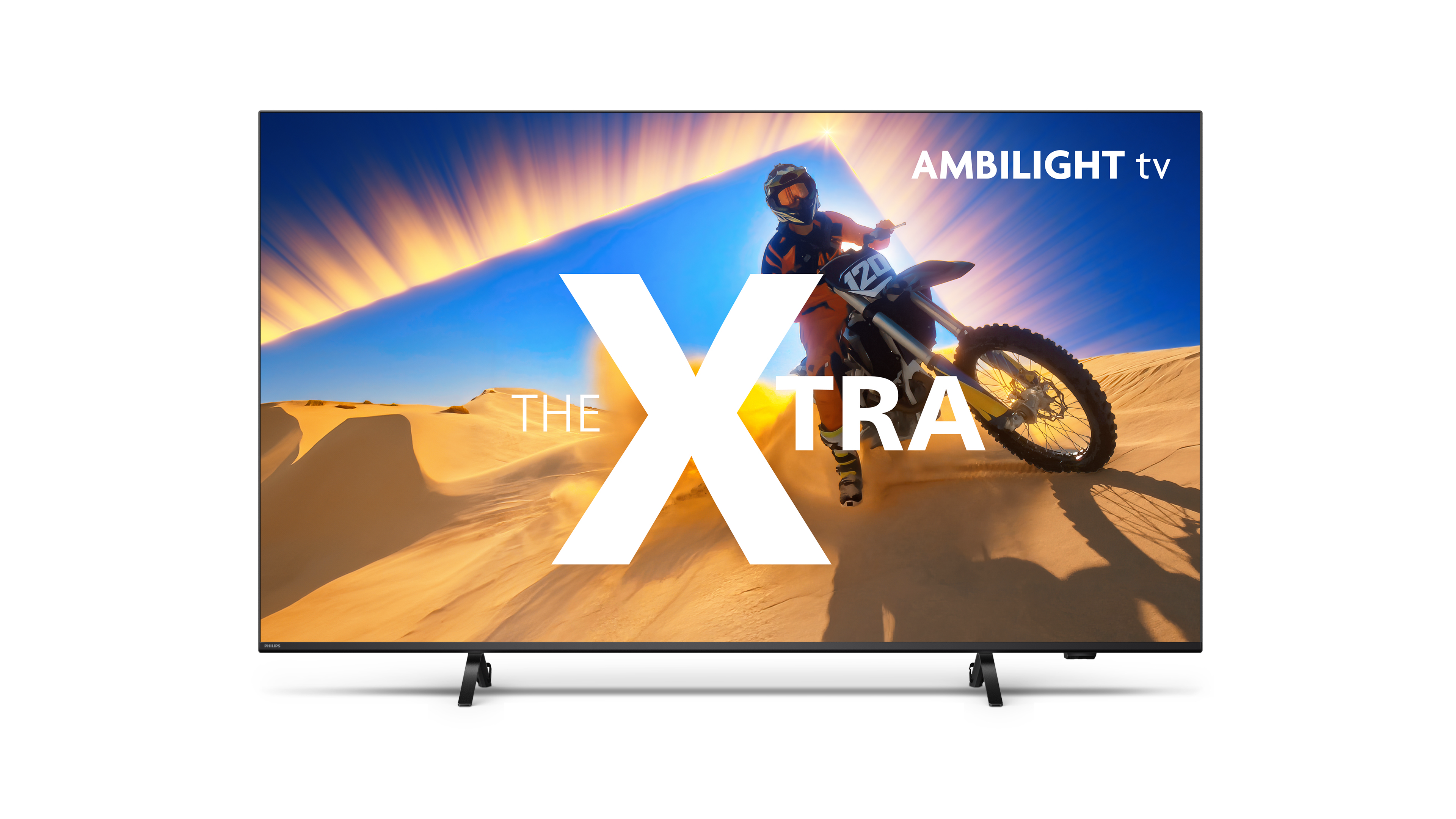
Now in its second year, the “Xtra Series” Mini LED model is a mid-range offering very much aimed at supporting the OLED flagships rather than competing with them.
As such the PML9009 is positioned, from a performance and pricing perspective, just below OLED but above its premium LED model.
From a design perspective, there’s a narrow metal bezel in a dark anthracite finish, which follows all the way down to its wide arch-rise feet.
It will be available in a selection of 55-, 65-, 75-, and for the first time, 85-inch screen sizes, giving customers plenty of choice.
The PML9009 packs the older 7th Gen P5 processor, a 144Hz panel capable of 98 per cent DCI and 1000-nits peak brightness, plus three-sided Ambilight.
However, since it uses a Novatek chip in place of the MediaTek Pentonic 1000, it does have four HDMI 2.1 inputs for 4K/144Hz gaming.
Like the OLED759, the PML9009 features Philips’ new Titan OS Smart TV platform in place of Google TV.
Philips PML9009 specs
- Sizes: 55, 65, 75, 85 inch
- Display type: Mini LED
- Resolution: 4K
- Processor: 7th Gen P5
- Sound: TBC
- HDMI 2.1: Yes (x4)
- Picture features: Three-sided Ambilight
- Gaming features: 4K/144Hz, VRR, ALLM
Philips PML9009 pricing
- Philips 55PML9009: £TBC / $TBC / AU$TBC
- Philips 65PML9009: £TBC / $TBC / AU$TBC
- Philips 75PML9009: £TBC / $TBC / AU$TBC
- Philips 85PML9009: £TBC / $TBC / AU$TBC
Philips PUS8909 - "The One"
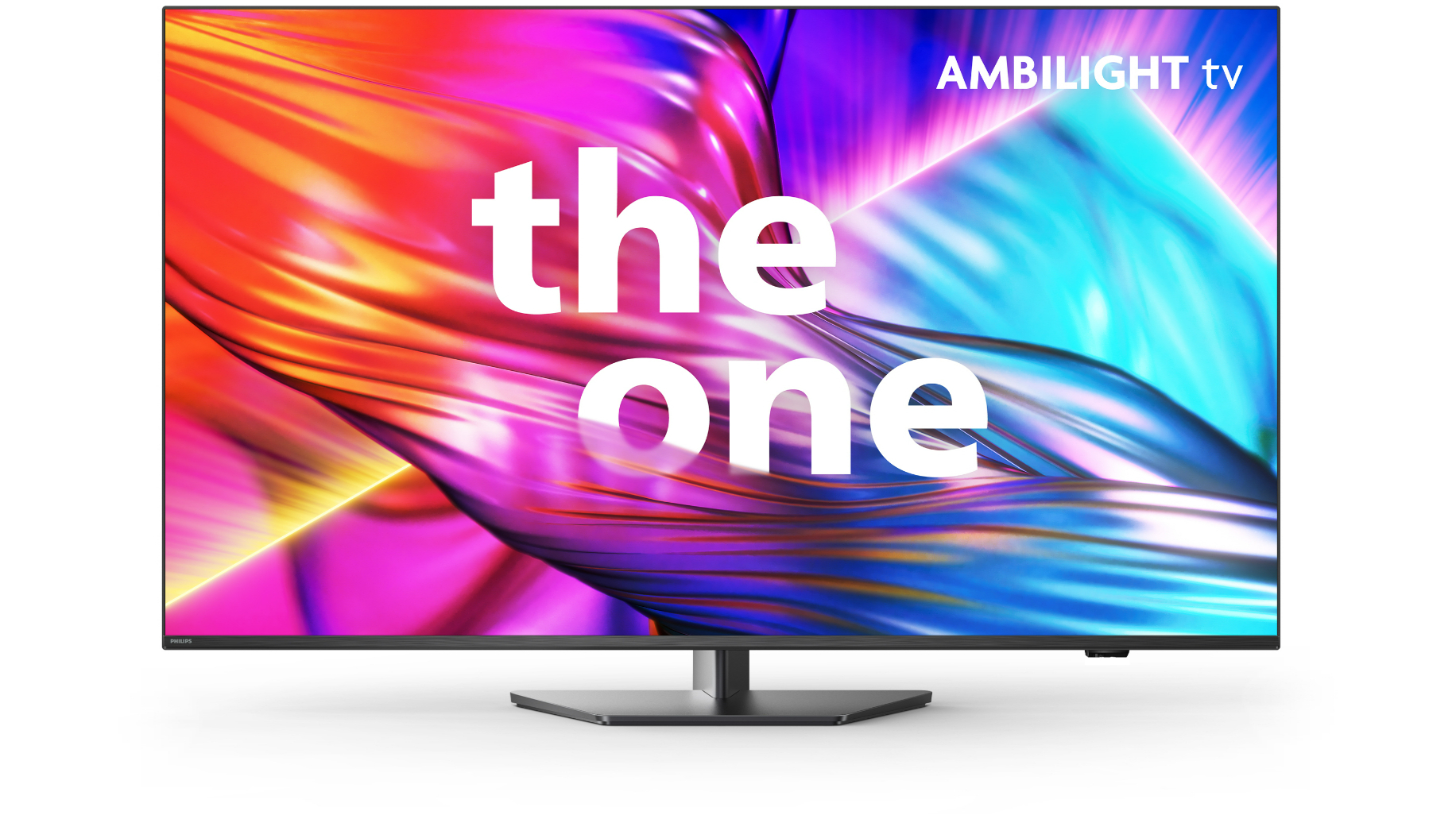
Philips “The One” Series is back to a suitably singular model this year – in 2023 we had two “The One” models, which considering the marketing around it, was confusing the say the least.
The concept behind this TV range is that for anyone confused about what it is they need in a TV, the Philips “The One” bundles in performance and key features at a competitive mid-range price.
This continues in 2024 with the new PUS8909 model available in 43-, 50-, 55-, 65- and 75-inch screen sizes, with the 7th Gen P5 processor and a 144Hz LCD panel.
Further picture quality details are low on the ground, but we do know that you’ll get three-sided Ambilight here, alongside that four-strong line up of HDMI 2.1 ports for top-notch gaming and sound.
It’s another anthracite grey slim metal bezel here, with a brushed effect that continues to the swivel central stand in all but the 75-inch model, which gets metal feet instead.
We'll update this with more detail on this TV as we get them.
Philips PUS8909 specs
- Sizes: 43, 50, 55, 65, 75 inch
- Display type: LCD
- Resolution: 4K
- Processor: 7th Gen P5
- Sound: TBC
- HDMI 2.1: Yes (x4)
- Picture features: Three-sided Ambilight
- Gaming features: 4K/144Hz, VRR, ALLM
Philips PUS8909 pricing
- Philips 42PUS8909: £TBC / $TBC / AU$TBC
- Philips 50PUS8909: £TBC / $TBC / AU$TBC
- Philips 55PUS8909: £TBC / $TBC / AU$TBC
- Philips 65PUS8909: £TBC / $TBC / AU$TBC
- Philips 75PUS8909: £TBC / $TBC / AU$TBC
MORE:
These are the best TVs you can buy right now
We see you wondering. What is Titan OS? Philips' new operating system explained
Verity is a freelance technology journalist and former Multimedia Editor at What Hi-Fi?.
Having chalked up more than 15 years in the industry, she has covered the highs and lows across the breadth of consumer tech, sometimes travelling to the other side of the world to do so. With a specialism in audio and TV, however, it means she's managed to spend a lot of time watching films and listening to music in the name of "work".
You'll occasionally catch her on BBC Radio commenting on the latest tech news stories, and always find her in the living room, tweaking terrible TV settings at parties.

